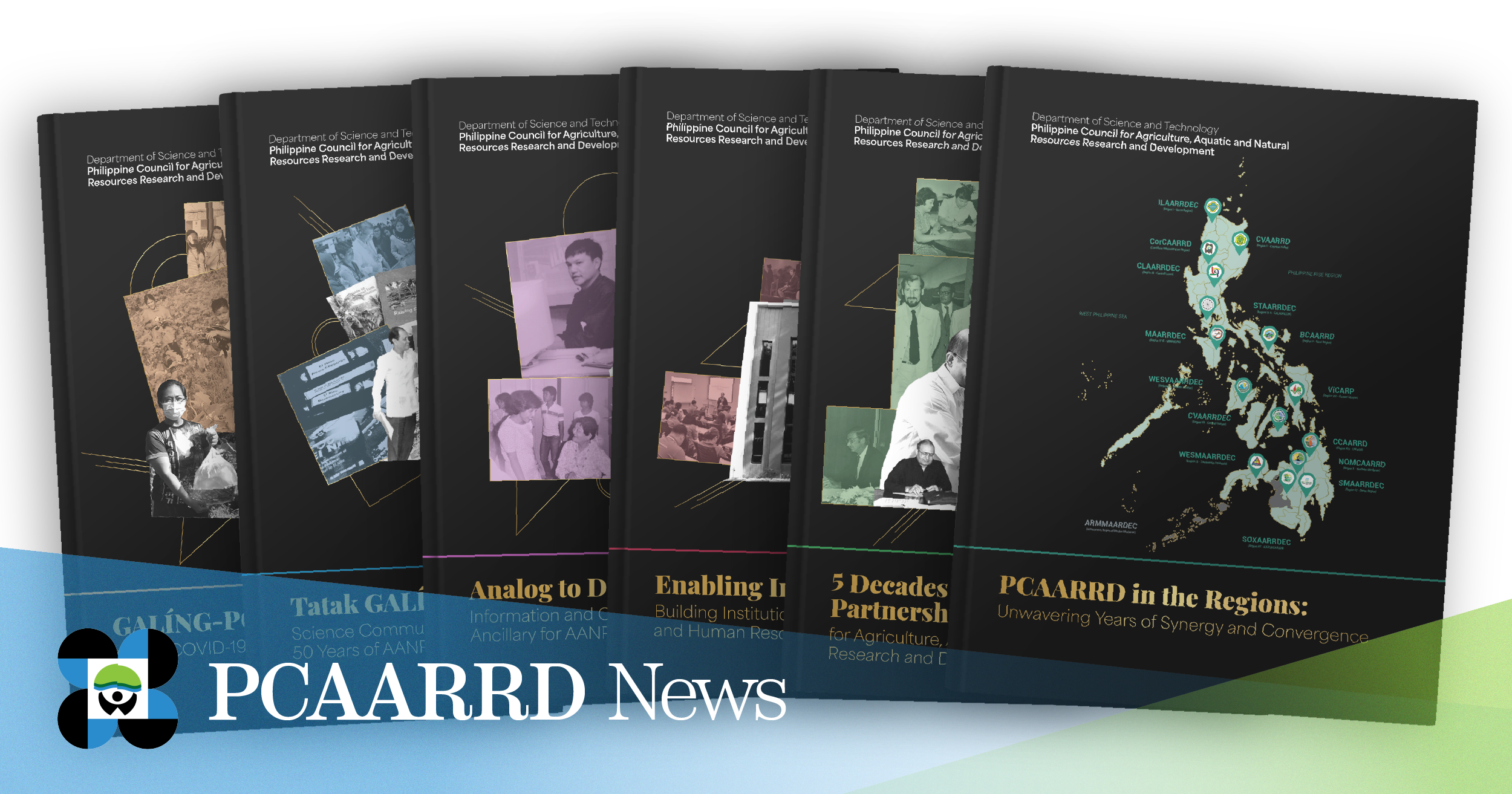The Philippine Council for Agriculture, Aquatic and Natural Resources Research and Development of the Department of Science and Technology (DOST-PCAARRD) has always prided itself on its accomplishments and prowess in research and development (R&D) in the agriculture, aquatic, and natural resources (AANR) sector. Always at the forefront, the Council’s programs and projects are widely known, thus making the Council synonymous with R&D. However, it should also be noted that behind the scientific discoveries and technological advancements is a sturdy support system making the wheels of R&D turn.
As part of its 50th founding anniversary, which was celebrated in November 2022, the Council launched the DOST-PCAARRD Legacy Books to pay homage to its divisions rendering administration, resource management, and support services that pave the way for success in R&D.
Behind DOST-PCAARRD’s success and accomplishments for more than 50 years are the men and women who nurtured the Council, the partnerships that have been established and institutionalized, and the various R&D support programs that helped the R&D sector withstand the test of time.
The DOST-PCAARRD Legacy Books are not just a part of DOST-PCAARRD’s countless mementos, but more so as a significant contribution to the Philippine AANR sector’s history and development—a tribute to those who worked hard to serve the Filipino people through the sharing and dissemination of the fruits of the AANR R&D in the country.
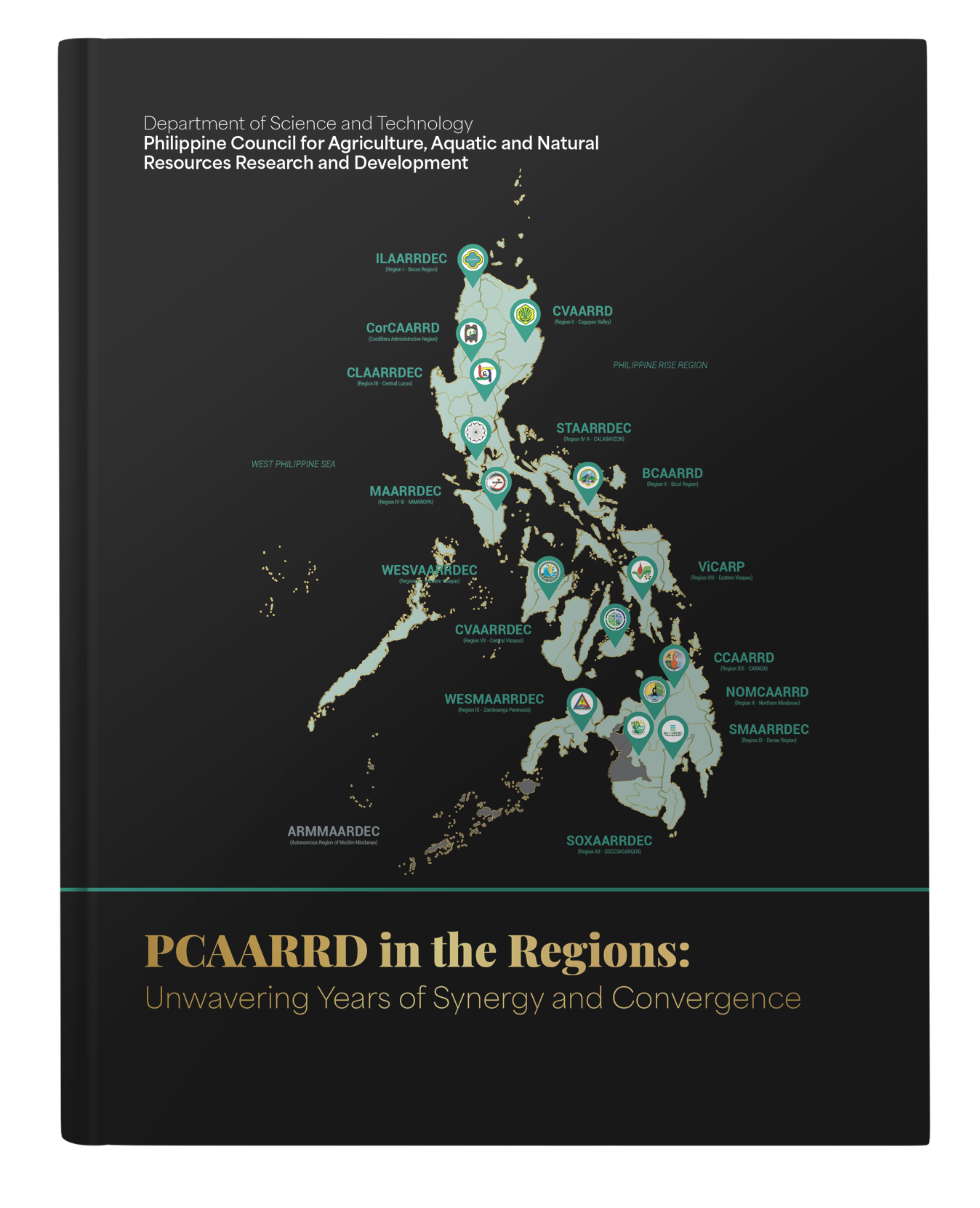
Book I: PCAARRD in the Regions: Unwavering years of Synergy and Convergence
DOST-PCAARRD considers the consortia mechanism an integral part of its regional R&D management system. As PCAARRD in the regions, the consortia network is regarded as the Council’s backbone for without it, the Council may not be able to stand on its own.
With the aim to elevate the R&D system in the country, the concept of the consortium as a management strategy had fostered the value of collaborative efforts within the network. It also made a significant step toward building regional responsibility and active participation in the Council’s commitment to achieving national goals. As the trailblazer of the consortium mechanism in the country, DOST-PCAARRD has influenced other government agencies to establish similar R&D networks to strengthen the research capability of the regions through coordination, which can eventually result in a stronger national research system.
The framework of the consortium as a management strategy is anchored on voluntary membership; pursuit of shared goals; division of labor for mutual benefit; an organization of equals; exchange or sharing of information at no cost; and a forum to resolve differences, discuss issues of common concern, and agree on a unified response.
Book I of the series highlights the journey of the Council’s consortium mechanism as a strategy to address R&D in the regions. It features the evolution of each consortium and its valuable contributions in steering the path for the development of the AANR sector.
The quest of the regional consortia toward S&T development, along with the notable accomplishments over the years, has been both fulfilling and inspirational. The numerous efforts
and breakthroughs highlighted in this book are tangible evidence of the partnership and collaboration of DOST-PCAARRD and the regional consortia in fulfilling their commitment to respond to the pressing needs of the AANR sector.
This publication also recognizes the men and women of the whole consortia system for their painstaking efforts and invaluable insights that led to its sustainability and continued success.
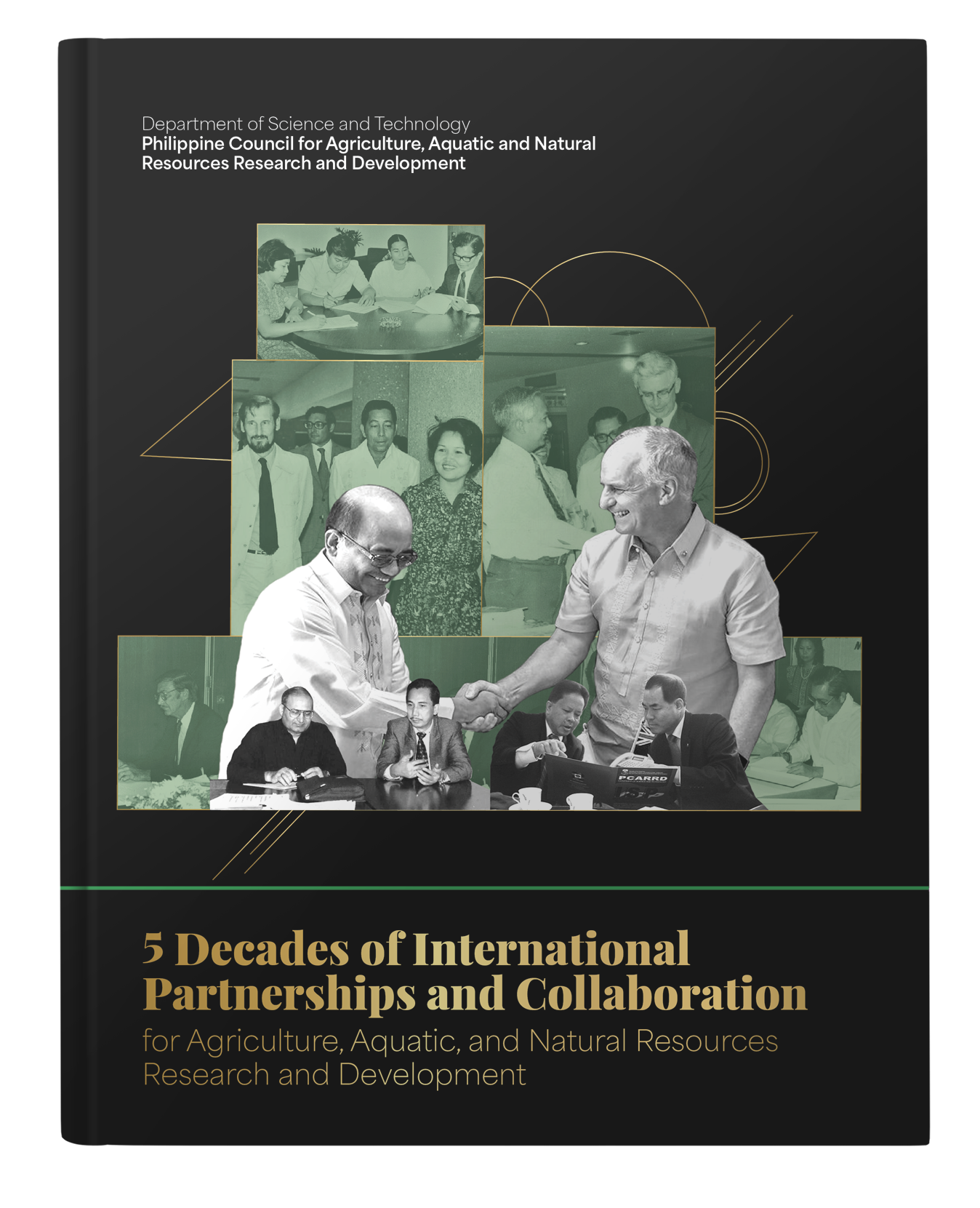
Book II: 5 Decades of International Partnerships and Collaboration for Agriculture, Aquatic, and Natural Resources Research and Development
DOST-PCAARRD started as a recipient of donor partner agencies for the implementation of its research programs, relying on international development aid to support various programs and projects. This ignited the start of a deep relationship with its bilateral, multilateral partners, and various international organizations and institutions.
The institutionalization of DOST-PCAARRD’s counterpart funding mechanism in its R&D programs and projects signaled a shift of bearing a greater role and responsibility in addressing various sectoral challenges. Likewise, the Council actively sought opportunities to not only learn from its institutional partners, but to also contribute to the body of knowledge and communities of practice of growing and emerging fields in the AANR sector. Through the years, DOST-PCAARRD's institutional partners had remained open and supportive—exploring new venues for collaborative exchanges and equally placing a stake in jointly implemented R&D endeavors that produce impactful AANR technologies and outcomes for the global community.
Collaborations provide the Council with various support and opportunities, defined by the breadth of engagement, resources commitments, and timeframe, and access to new knowledge, innovations, and state-of-the-art methods and technologies that will be useful and meet the needs in the national context. Equally important are the opportunities provided by DOST-PCAARRD’s partners to showcase Filipino innovation and global competitiveness—the Council’s contribution to the increasingly shared knowledge economy of the international community.
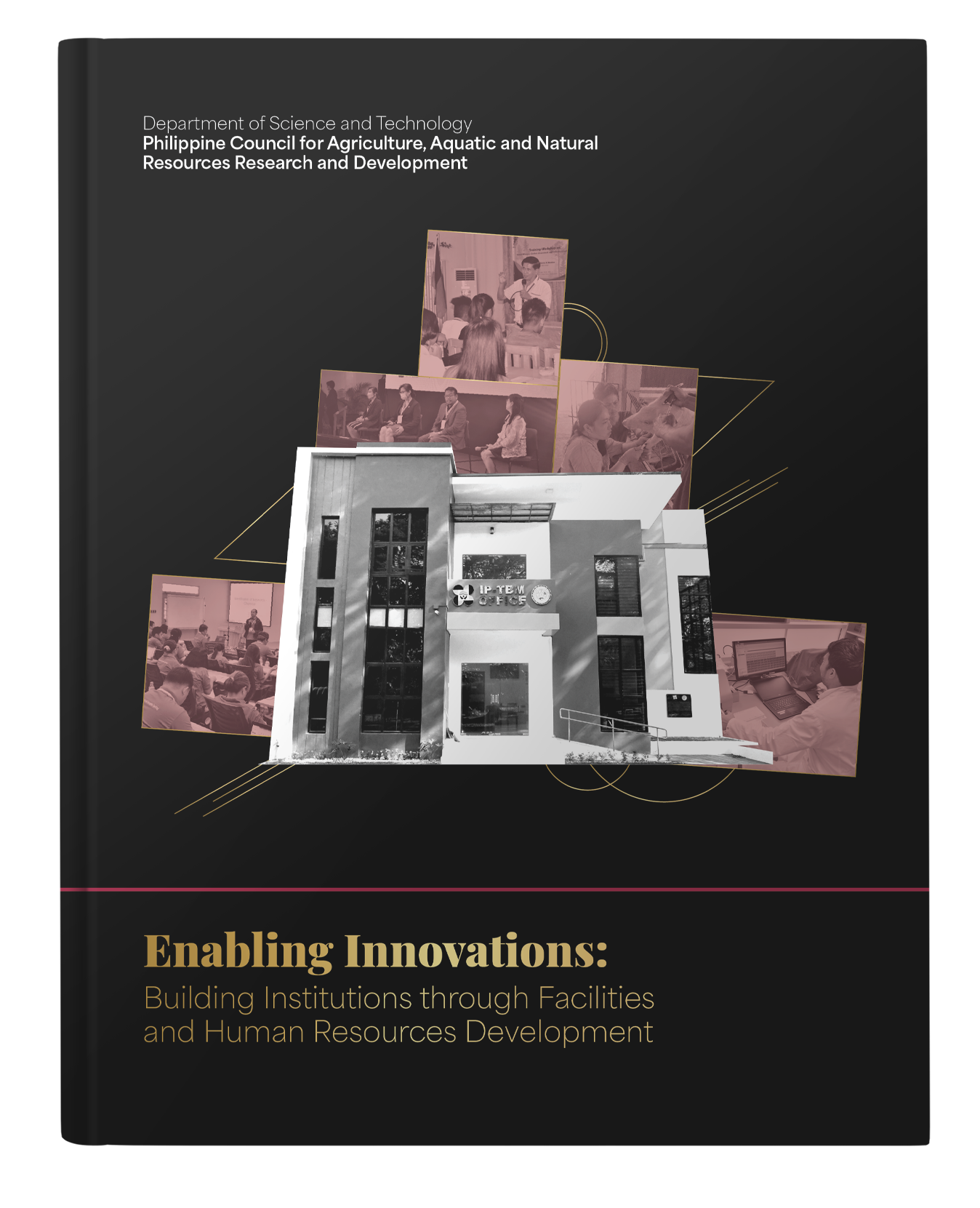
Book III: Enabling Innovations: Building Institutions through Facilities and Human Resources Development
For DOST-PCAARRD, capability building in the form of infrastructure, equipment, and facilities development, as well as human resources development, is primary.
The Council is all about R&D innovation and the generation of technologies and information in the AANR sector for national development. To be able to generate all these outputs, it is necessary to have facilities, laboratories, and equipment, as well as capable human resources all over the country.
In the early years of its existence, DOST-PCAARRD focused its resources in establishing a network of research centers in strategic locations in the country, starting with Benguet, Cagayan Valley, Central Luzon, Bicol, La Granja, and Northern and Southern Mindanao. This was followed by support to multi-commodity and single commodity research centers such as University of the Philippines Los Baños (UPLB) and Visayas State College of Agriculture (ViSCA). It was also during this time that the PCAARRD Headquarters was built.
Apart from facilities and infrastructure, DOST-PCAARRD also developed degree programs, which enabled the Council to support almost 1,000 scholars, and non-degree training programs, which supported more than 5,000 beneficiaries.
This publication narrates the major focus and investments in infrastructure and manpower development that were made as early as the 1970s and how the Council recognized the importance of capacity building and governance and, as such, officially declared it as one of the Council’s banner programs in the 1980s.
Today, DOST-PCAARRD continues to recognize the need to constantly upgrade capacities of R&D institutions as the country faces new and exciting challenges and opportunities in the face of changing technological advancement. The Council and its stakeholders recognize that it should continue to strive to improve and keep up with the challenges and opportunities in the R&D landscape. With this, a network of institutions and researchers and scientists working along their fields of specialization exists as a robust R&D system. DOST-PCAARRD was able to provide and will continue to provide support to enable the system to remain robust and responsive to the needs of the country.
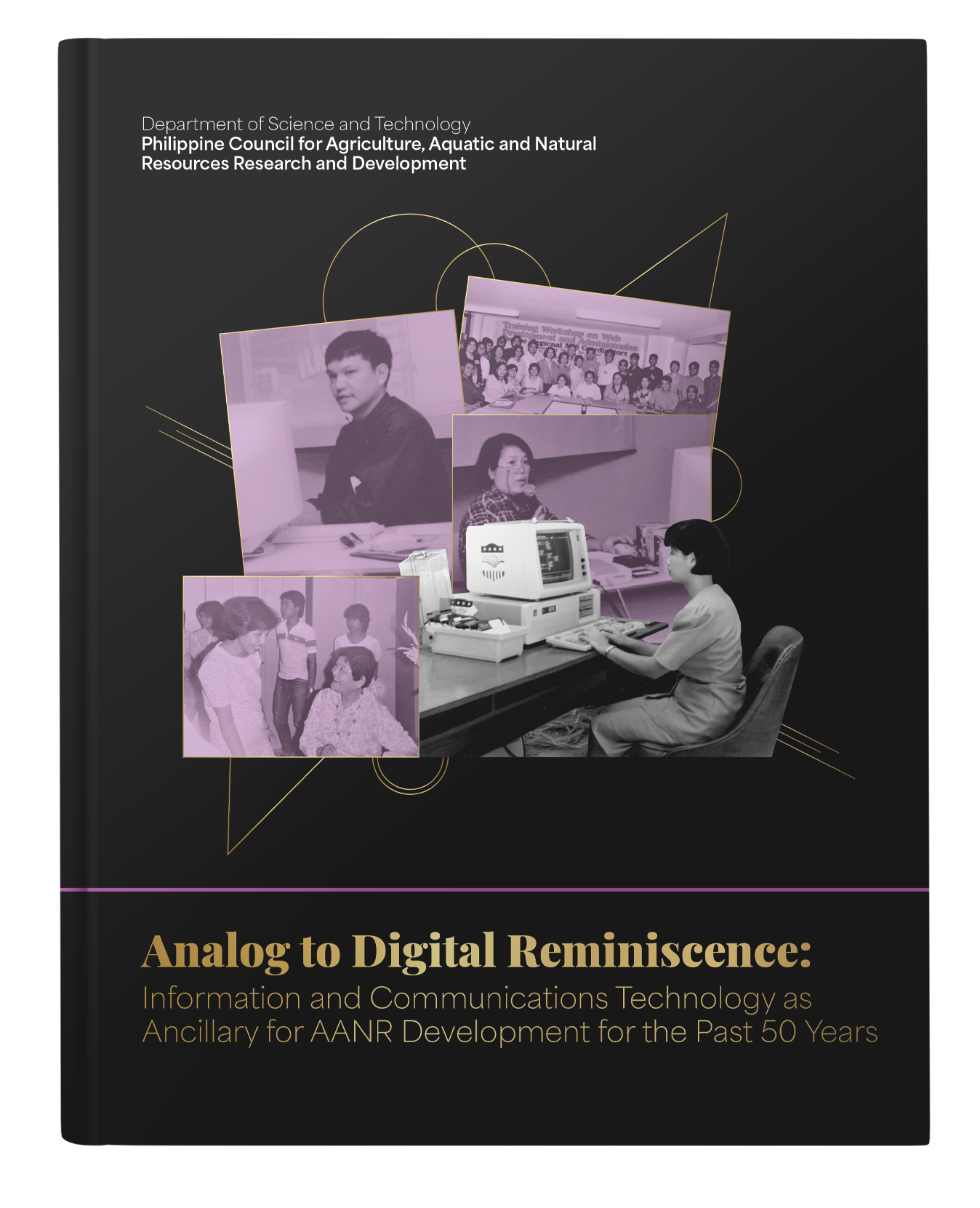
Book IV: Analog to Digital Reminiscence: Information and Communications Technology as Ancillary for AANR Development for the Past 50 Years
Information and communications technology (ICT) has been regarded as a significant driving force in the management of R&D data in the Council. As DOST-PCAARRD continued to accumulate voluminous amounts of data from its projects, the need to effectively and efficiently manage it materialized, thus turning to modern computing as a solution. DOST-PCAARRD maintained to keep itself abreast of the latest in ICT, actively adopting technologies that best suited its needs at the time. From primordial forms of technology such as keypunch machines, punch cards, and typewriters, the Council’s technological reserve now includes high-end servers, state-of-the-art computers, and top-level connectivity to assist in achieving its goals. PCAARRD prides itself as one of the first agencies to employ ICT in the management of its R&D endeavors.
Book IV of the Legacy Books goes beyond the traditional annals of achievements and presents a larger narrative of technological innovation in support of a very dynamic organization that had survived different administrations, trials, and challenges in research management to support agricultural development. Furthermore, it seeks to guide future generations not only to learn, but also to grow and further advance the pioneering efforts that DOST-PCAARRD's predecessors have built and worked so hard for to meet the technological challenges in the future in support of agriculture and R&D management.
For five decades and the ones to come, ICT has and will continue to serve as an unyielding pillar for information management, and function as the backbone for communication and partnerships in the agriculture, aquatic and natural resources sectors. Through the efforts of its directors and staff, both past and present, ICT has been established not just as a tool, but a way of living in fast changing times.
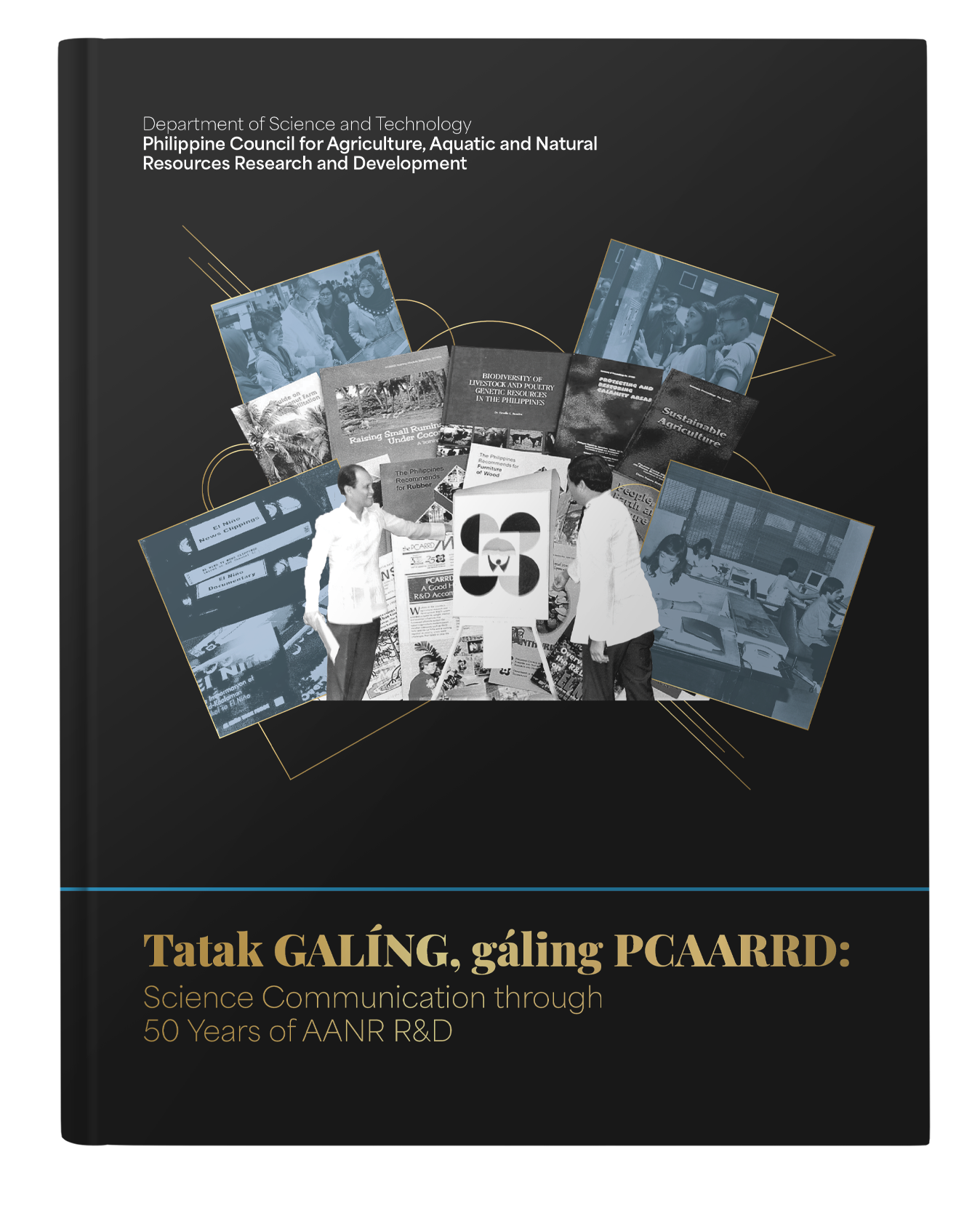
Book V: Tatak GALING, gáling PCAARRD: Science communication through 50 years of AANR R&D
From the creation of the Council in 1972, communication and promotion have played key roles in addressing the fragmented, undirected, and redundant research initiatives across the country. S&T workers tirelessly research on and develop innovations to improve the lives of their fellow men. While there is great value in the R&D of technologies, products, and services, on the other end of the spectrum is R&D results utilization (RDRU), which is one of the banner programs of DOST-PCAARRD.
In the past 50 years, the Council has produced a myriad of information, education, and communication (IEC) materials disseminated through various platforms to its stakeholders and partners. The next decades of DOST-PCAARRD hold even more diverse opportunities, interventions, and initiatives in science communication that the Council plans to utilize and, possibly, enhance to better fit the needs of its target audience and beneficiaries.
What started out as simple publications created using typewriters and reproduced in mimeographs and in offset have evolved through the years into various forms, such as quality print and digital publications shared through the Council’s circulation, exhibits and S&T events, tri-media, and digital platforms.
Book V in the series features the long and rich history of science communication in DOST-PCAARRD. It depicts the simplicity of communication when the Council was just established and how it evolved through the years as new technologies and interventions were discovered, adopted, and innovated. As more platforms and avenues in knowledge sharing are discovered and as technology progresses, DOST-PCAARRD’s communication arm strives to keep pace with the ever-changing trends, especially in science communication, which merges both science and art into one.

Book VI: GALING-PCAARRD Kontra COVID-19 Program
GALING-PCAARRD chronicles the response of the Council to the government-led efforts against the coronavirus (COVID-19) pandemic in accordance with the Bayanihan to Heal as One Act. It documented the accomplishments of the different projects under its six components catering to among others, the affected families, farmers, fisherfolk, employees, students, and frontliners and health workers.
Book VI of the Legacy Books details DOST-PCAARRD’s trailblazing accomplishments in areas other than direct R&D activities. It highlights the importance of providing a conducive environment for the successful conduct of R&D in the AANR sector across the country and provides a bigger picture on how the Council adapts to new challenges and impacts of a constantly changing environment, while delivering its mission in providing strategic leadership in promoting S&T as a platform for AANR product innovation and environment resiliency.
This publication shows how the Council was able to initiate S&T and R&D interventions including provision of immediate food relief and assistance to affected individuals and communities; information dissemination and technical assistance in providing livelihood opportunities to communities and families; and generation of technologies and strategies to address constraints on production, marketing, and viability of the food supply chain and non-food products in general, among other interventions.
The Council not only contributed significantly in alleviating food security concerns during the lockdown, but also established a foundation for rebuilding the AANR sector towards greater productivity and resiliency in the new normal.
Guided by its core values of relevance, excellence, and cooperation, DOST-PCAARRD will remain steadfast in catalyzing the Philippine AANR sector toward self-sufficiency and global competitiveness.
The DOST-PCAARRD Legacy Books may be viewed at the DOST-PCAARRD eLibrary office located at the DOST-PCAARRD Innovation and Technology Center (DPITC) in Los Baños, Laguna. Interested readers may also access e-copies of the publication, as well as other resource materials in AANR, at https://elibrary.pcaarrd.dost.gov.ph/home. Registration and downloads are free of charge.

